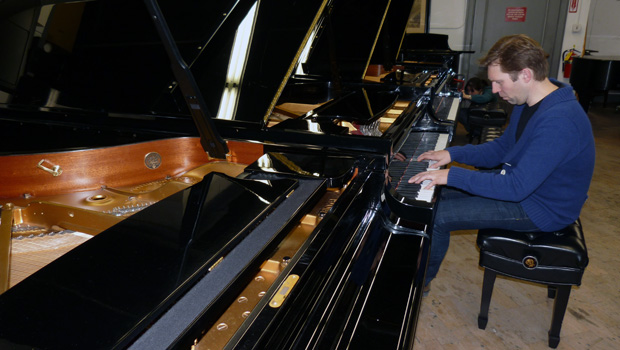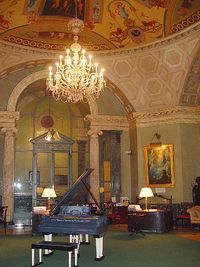Steinway
Hall is the name of buildings housing concert halls, showrooms and
sales departments for Steinway & Sons pianos. The first Steinway
Hall was opened 1866 in New York City. Wikipedia
| Hours: |
|
Phone: (212) 246-1100
Address: 109 West 57th Street, New York, NY 10019
蕭太太是中學的音樂老師,她說其實老師要萬能,她還教過美術呢。她有二台鋼琴。可趁此談與Steinway & Sons 產品的緣份。 我跟她說紐約時報近七年前有系列的介紹該公司:
Wikipedia article Steinway & Sons.此文內有一百多條的出處注解,蕭太太給我們看的專書一定在其中。 那書前三分之一是介紹其歐美的家族,並說美國的鋼琴製造樹立了世 界的標準。接下來的篇幅都記諸名演奏家與該公司的琴緣。
Steinway to Sell its Landmark Hall for $195 Million
Thursday, November 15, 2012 - 11:38 AM
The music could be over soon at Steinway Hall, the elegant, 87-year-old piano showroom near Carnegie Hall.
Steinway Musical Instruments, the maker of the famous piano
brand, has signed a letter of intent to sell its flagship building at
109 W. 57th Street for $195 million. The company has been losing about
$5 million annually on the beaux arts building, and it expects to either
vacate it or stay as a tenant and occupy a smaller space within the
building.
In a conference call with investors on Monday, Michael Sweeney, Steinway’s president and CEO, identified the building's buyer only as a real estate developer.
The transaction is to be a three-way deal in which Steinway, which owns the building, will receive $56 million and the owner of the land will get $140 million. A completed deal is anticipated by the end of the year. Julie Theriault, a Steinway spokesperson, said a decision about a potential move is not expected immediately. “We’re not going anywhere for at least 12 months,” she said.
The sale was first reported by Bloomberg News on Wednesday.
Steinway Hall was built by the Steinway & Sons piano company in 1925 as a showroom for its instruments. With its marble columns, wood paneling and ornate ceilings, the space contains three floors of concert grands, baby grands and uprights. The building is presently home to the company’s sales, marketing and service departments and it hosts concerts in its two-story rotunda.
The building was registered as a historic and cultural landmark in 2001, meaning the city's Landmarks Preservation Commission must approve any new uses or changes. With its proximity to Carnegie Hall and other arts institutions, the hall has been a gathering spot for generations of pianists. Vladimir Horowitz and Serge Rachmaninoff met there in 1928, their first time playing together. They worked on Rachmaninoff's Piano Concerto No. 3, which became one of Horowitz's signature pieces.
Steinway has been actively looking to sell Steinway Hall for several years now, and was close to a deal before the real estate market collapsed in 2008, according to Theriault. The company began letting its leases with the building’s office tenants expire, including The Economist magazine. The lack of rental income put new urgency on closing a deal. Recently, the showroom was closed for two weeks in the aftermath of Superstorm Sandy, although Sweeney said the storm's larger impact on the company was negligible.
Steinway reports its income for the third quarter of 2012 was essentially flat. But the growth market for pianos has shifted to Asia, with sales in China up 31 percent and in Japan up 50 percent over the same quarter last year. By contrast, sales in the Americas were down 14 percent. Steinway has major showrooms in London, Berlin and Vienna, as well as smaller sales offices around the world.
Jeffrey Biegel, a concert pianist and Steinway artist, remembers rehearsing in the cavernous basement as a student at Juilliard in the late 1970s, when Ravel's Scarbo became a duet with a noisy heating system. He returned over the decades for numerous recitals, master classes and the dedication of a portrait of Horowitz. "The ghosts of all the great artists are there," he said. "I’m hopeful that if the sale does go through they’ll be allowed to stay as long as possible."
Below: Leif Ove Andsnes rehearses at Steinway Hall in February 2012 (Photo: Eileen Delahunty).

In a conference call with investors on Monday, Michael Sweeney, Steinway’s president and CEO, identified the building's buyer only as a real estate developer.
The transaction is to be a three-way deal in which Steinway, which owns the building, will receive $56 million and the owner of the land will get $140 million. A completed deal is anticipated by the end of the year. Julie Theriault, a Steinway spokesperson, said a decision about a potential move is not expected immediately. “We’re not going anywhere for at least 12 months,” she said.
The sale was first reported by Bloomberg News on Wednesday.
Steinway Hall was built by the Steinway & Sons piano company in 1925 as a showroom for its instruments. With its marble columns, wood paneling and ornate ceilings, the space contains three floors of concert grands, baby grands and uprights. The building is presently home to the company’s sales, marketing and service departments and it hosts concerts in its two-story rotunda.
The building was registered as a historic and cultural landmark in 2001, meaning the city's Landmarks Preservation Commission must approve any new uses or changes. With its proximity to Carnegie Hall and other arts institutions, the hall has been a gathering spot for generations of pianists. Vladimir Horowitz and Serge Rachmaninoff met there in 1928, their first time playing together. They worked on Rachmaninoff's Piano Concerto No. 3, which became one of Horowitz's signature pieces.
Steinway has been actively looking to sell Steinway Hall for several years now, and was close to a deal before the real estate market collapsed in 2008, according to Theriault. The company began letting its leases with the building’s office tenants expire, including The Economist magazine. The lack of rental income put new urgency on closing a deal. Recently, the showroom was closed for two weeks in the aftermath of Superstorm Sandy, although Sweeney said the storm's larger impact on the company was negligible.
Steinway reports its income for the third quarter of 2012 was essentially flat. But the growth market for pianos has shifted to Asia, with sales in China up 31 percent and in Japan up 50 percent over the same quarter last year. By contrast, sales in the Americas were down 14 percent. Steinway has major showrooms in London, Berlin and Vienna, as well as smaller sales offices around the world.
Jeffrey Biegel, a concert pianist and Steinway artist, remembers rehearsing in the cavernous basement as a student at Juilliard in the late 1970s, when Ravel's Scarbo became a duet with a noisy heating system. He returned over the decades for numerous recitals, master classes and the dedication of a portrait of Horowitz. "The ghosts of all the great artists are there," he said. "I’m hopeful that if the sale does go through they’ll be allowed to stay as long as possible."
Below: Leif Ove Andsnes rehearses at Steinway Hall in February 2012 (Photo: Eileen Delahunty).


沒有留言:
張貼留言